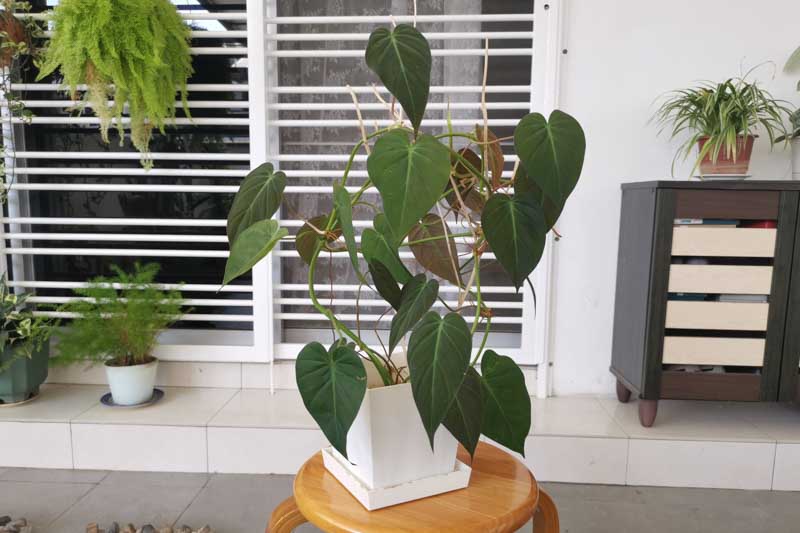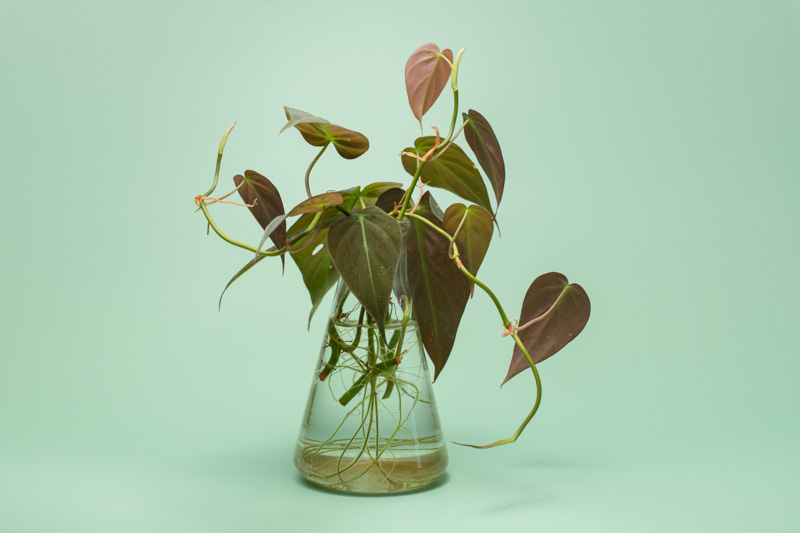Ivy-Leaf Philodendron, Velvet-Leaf Philodendron, Philodendron hederaceum var. hederaceum, Philodendron scandens, Philodendron scandens subsp. scandens
Philodendron micans, with its unique velvet-textured leaves and captivating hues, stands out as a jewel among the Philodendron family. This particular species combines the classic appeal of Philodendrons with a distinctive flair, making it a favorite among houseplant enthusiasts.
Philodendron micans exhibits a mesmerizing display of iridescent leaves that range in color from deep green to rusty brown, depending on the light. The leaves are small compared to other Philodendrons, but what they lack in size, they make up for in texture and color. The velvety surface of the leaves catches the light in a way that is truly unique, giving the plant a luminous quality.
Native: Native to the Caribbean (including Mexico and parts of Central America), Philodendron micans thrives in tropical climates. It is found in the dense, moist, and shaded environments of these regions, growing as an epiphyte or hemiepiphyte in the wild. It belongs to the arum family (Araceae), along with Zantedeschia (Calla Lily), Caladium (Angel Wing), Monstera (Swiss Cheese Plant), or Colocasia (Elephant Ear).
Plant Type and Habit: Philodendron micans is a fast-growing, tropical evergreen plant characterized by its trailing or climbing habit. In its natural setting, it uses aerial roots to attach itself to larger trees, climbing towards the canopy to access sunlight. Indoors, it can be encouraged to climb a moss pole or allowed to trail beautifully from a hanging pot or shelf.
Size: When grown as a houseplant, Philodendron micans can reach 8 inches in height (20 cm) and 24 inches in length (60 cm).
Flowers: While Philodendron micans can produce flowers, it is a rare occurrence in household environments. The plant’s flowers are typical of the genus, featuring a spadix surrounded by a spathe, but they are not the primary reason this plant is cultivated.
Foliage: The foliage of Philodendron micans is undoubtedly its most striking feature. The heart-shaped leaves, with their velvet-like texture and iridescent colors, are a sight to behold. The unique appearance of the leaves, which can change hues from green to bronze to deep burgundy, adds an element of dynamic beauty to the plant’s overall appeal.
Hardiness: If planted outdoors, this plant is hardy in USDA zones 10-12. It is best suited to indoor environments where temperatures can be kept consistent, ideally between 65-85°F (18-29°C). It is not frost-tolerant and should be protected from cold drafts.
Uses: Philodendron micans is primarily used for ornamental purposes, thanks to its stunning foliage and versatile growth habit. It is a popular choice for adding a touch of tropical elegance to interior spaces, whether displayed on a bookshelf, in a hanging basket, or climbing a trellis.
Toxicity: Philodendrons are toxic to humans, cats, and dogs if ingested. They contain calcium oxalate crystals that can cause mouth and stomach irritation. Contact with the sap may cause skin irritation.
Deer and Rabbits: Its toxicity generally deters deer and rabbits.
Benefits: Beyond its aesthetic value, it also helps purify the air, making it a functional as well as a beautiful addition to homes and offices.

Light: Philodendron micans prefers bright, indirect light to maintain its unique coloring. Avoid direct sunlight, which can scorch their leaves.
Soil: Use a well-draining, peat-based potting mix. Philodendron micans prefers slightly acidic to neutral pH levels. Ensure the pot has drainage holes to prevent water from accumulating at the bottom.
Water: Water your Philodendron micans when the top inch of soil feels dry to the touch. Over-watering can lead to root rot, so ensure proper drainage.
Temperature and Humidity: Ideal temperatures range between 65°F and 85°F (18°C to 29°C). Philodendrons can tolerate a wider range, but sudden temperature drops or exposure to cold drafts should be avoided. These tropical plants enjoy high humidity, between 50-60%, but can adapt to average household humidity levels. For added humidity, mist the leaves regularly, place a humidifier nearby, or set the plant on a pebble tray filled with water.
Fertilization: Feed your Philodendron micans with a balanced, water-soluble fertilizer every 4-6 weeks during the growing season (spring and summer). Reduce feeding in fall and winter when growth slows.
Pruning: Pruning is not strictly necessary but can help maintain shape and encourage fuller growth. Use sterile scissors or pruning shears to trim away any yellow or damaged leaves and to manage size.
Repotting: Repot every 2-3 years or when roots start to crowd the pot. Choose a pot that is one size larger than the current one to ensure continued growth.
Propagating Philodendron plants is a straightforward and rewarding process, allowing you to expand your collection or share with friends and family. The most common method is stem cuttings, which can be rooted in water or soil. Here’s how to do it:
Choose a Healthy Stem: Look for a healthy stem with at least 2-3 leaves and a few nodes (the points on the stem where leaves attach and roots tend to grow).
Make the Cut: Using a clean, sharp knife or scissors, cut just below a node. The cutting should be about 4-6 inches long.
Prepare the Cutting: Remove any leaves that would be submerged when you place the stem in water to prevent rot.
Root in Water: Place the cutting in a glass or jar of water, ensuring the node is submerged. Leave the leaves out of the water. Place the jar in a warm, bright spot with indirect light.
Change the Water Regularly: Refresh the water every few days to keep it clean, which helps prevent bacterial growth.
Wait for Roots: Roots should start to emerge from the nodes in about 2-4 weeks. Wait until the roots are a few inches long before potting.
Potting: Once the roots are sufficiently developed, plant the cutting in a pot with well-draining soil. Care for it as you would a mature Philodendron.
Prepare Your Cutting: Follow the same steps as above to select and cut a healthy stem section.
Rooting Hormone (Optional): Dip the cut end of the stem in rooting hormone powder to encourage root growth. This step is optional but can enhance rooting success.
Plant the Cutting: Fill a pot with a well-draining potting mix. Make a hole in the center and insert the cut end of the stem, ensuring at least one node is buried beneath the soil surface.
Water and Cover: Water the soil lightly to settle it around the cutting. To create a humid microenvironment, you can cover the pot with a plastic bag or place it in a propagator. Ensure the leaves are not touching the plastic to prevent rot.
Care for Your Cutting: Place the pot in a warm, bright location with indirect light. Keep the soil consistently moist but not waterlogged.
Wait for Growth: In a few weeks, the cutting should start to root. You can gently tug on the plant after about 4 weeks; if there’s resistance, roots have formed.

Philodendrons can encounter pests, diseases, and other common problems, especially when grown indoors.
Spider Mites: These tiny pests can be identified by the fine webs they weave on the plant. They cause yellowing or speckled leaves. Increase humidity around the plant and wash it with a strong stream of water. For severe infestations, use insecticidal soap or neem oil.
Mealybugs: These white, cottony pests tend to cluster in leaf axils and under leaves, sucking sap and weakening the plant. Remove with alcohol-dipped cotton swabs or apply neem oil.
Aphids: Small, soft-bodied insects that can be green, black, brown, or pink, aphids typically feed in groups on the undersides of leaves. Combat them with a gentle spray of water, neem oil, or insecticidal soap to protect the plant’s health and appearance.
Scale insects: Hard or soft-bodied insects that attach themselves to the stems or leaves, causing yellowing and growth stunting. Scrape off with a fingernail or use a cotton swab dipped in rubbing alcohol. Insecticidal soap or neem oil may also be used.
Root rot: Overwatering is the primary cause, leading to brown, mushy roots and yellowing leaves. Reduce watering, improve drainage, and repot the plant into fresh, well-draining soil. Severely affected roots should be trimmed before repotting.
Leaf spot: Fungal or bacterial infections can cause dark or black spots on leaves, often with a yellow halo. Increase air circulation, avoid wetting leaves when watering, and remove affected leaves. Fungicides or bactericides may be necessary in severe cases.
Yellowing Leaves: Overwatering, poor drainage, or nutrient deficiencies can cause leaves to turn yellow. Adjust watering habits, ensure the pot has adequate drainage, and consider applying a balanced, water-soluble fertilizer.
Leggy Growth or Small Leaves: Insufficient light can lead to stretched stems and smaller than normal leaves. Move the plant to a location with more indirect light.
Loss of Variegation: If variegated Philodendrons revert to solid green, it’s often due to insufficient light. Increase light exposure, but avoid direct sunlight to encourage variegation.
Brown Leaf Tips: Often a sign of low humidity or salt buildup from tap water. Increase humidity around the plant and consider using filtered water or rainwater.
| Hardiness |
10 - 12 |
|---|---|
| Plant Type | Houseplants, Climbers, Perennials |
| Plant Family | Araceae |
| Genus | Philodendron |
| Exposure | Partial Sun |
| Season of Interest |
Spring (Early, Mid, Late) Summer (Early, Mid, Late) Fall Winter |
| Height |
8" - 2' (20cm - 60cm) |
| Maintenance | Low |
| Water Needs | Average |
| Soil Type | Loam |
| Soil pH | Acid, Neutral, Alkaline |
| Soil Drainage | Moist but Well-Drained |
| Characteristics | Showy, Evergreen |
| Tolerance | Deer, Rabbit |
| Garden Uses | Hanging Baskets, Patio And Containers |
| Hardiness |
10 - 12 |
|---|---|
| Plant Type | Houseplants, Climbers, Perennials |
| Plant Family | Araceae |
| Genus | Philodendron |
| Exposure | Partial Sun |
| Season of Interest |
Spring (Early, Mid, Late) Summer (Early, Mid, Late) Fall Winter |
| Height |
8" - 2' (20cm - 60cm) |
| Maintenance | Low |
| Water Needs | Average |
| Soil Type | Loam |
| Soil pH | Acid, Neutral, Alkaline |
| Soil Drainage | Moist but Well-Drained |
| Characteristics | Showy, Evergreen |
| Tolerance | Deer, Rabbit |
| Garden Uses | Hanging Baskets, Patio And Containers |
How many Philodendron micans (Velvet-Leaf Philodendron) do I need for my garden?
| Plant | Quantity | |
|---|---|---|
| Philodendron micans (Velvet-Leaf Philodendron) | N/A | Buy Plants |
Create a membership account to save your garden designs and to view them on any device.
Becoming a contributing member of Gardenia is easy and can be done in just a few minutes. If you provide us with your name, email address and the payment of a modest $25 annual membership fee, you will become a full member, enabling you to design and save up to 25 of your garden design ideas.
Join now and start creating your dream garden!
Create a membership account to save your garden designs and to view them on any device.
Becoming a contributing member of Gardenia is easy and can be done in just a few minutes. If you provide us with your name, email address and the payment of a modest $25 annual membership fee, you will become a full member, enabling you to design and save up to 25 of your garden design ideas.
Join now and start creating your dream garden!